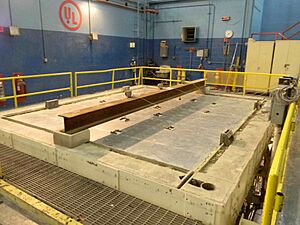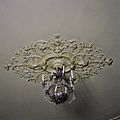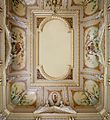Ceiling facts for kids
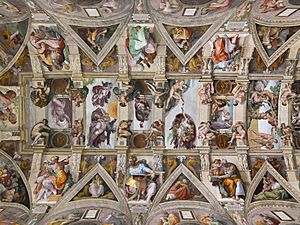
A ceiling is the top inside surface of a room. It's what you see when you look up! Ceilings are usually not part of the main structure of a building. Instead, they are a finished surface. They hide the underside of the roof or the floor of the room above.
Ceilings can be decorated in many ways. You can find beautiful frescoes (paintings on wet plaster) and other artwork on ceilings. Many famous examples are in religious buildings.
One common type is the dropped ceiling. This ceiling hangs down from the structure above it. The space above a dropped ceiling can hide pipes, wires, or air ducts. It can also hold insulation or materials that help stop fires. Other types of ceilings include the cathedral ceiling, the curved (or barrel-shaped) ceiling, the stretched ceiling, and the coffered ceiling. Sometimes, a decorative trim called coving connects the ceiling to the walls. Ceilings can also help make a building safer from fire.
Contents
What Are the Different Kinds of Ceilings?
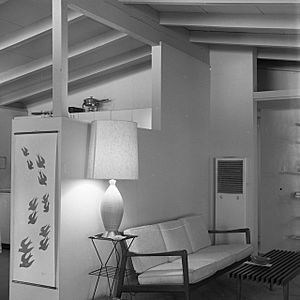
Ceilings are named based on how they look or how they are built.
Cathedral Ceilings
A cathedral ceiling is a very tall ceiling. It looks like the high ceilings you might see in a large church. These ceilings make a room feel very open and grand.
Dropped Ceilings
A dropped ceiling is built a bit lower than the main structure above it. This can be done for several reasons:
- To make the room feel more comfortable.
- To help block sound (acoustic damping).
- To create space for HVAC (heating, ventilation, and air conditioning) systems or piping.
Curved and Coffered Ceilings
A concave or barrel-shaped ceiling is curved or rounded upwards. This can look nice or help sound travel better in a room. A coffered ceiling has a pattern of sunken square or octagon shapes. These shapes are also called "lacunar" panels.
Cove and Stretched Ceilings
A cove ceiling uses a curved plaster transition where the wall meets the ceiling. It's named after "cove molding," which has a concave curve. A stretched ceiling uses special panels, often made of PVC, that are stretched and attached to a rail around the room's edge.
Decorating Ceilings: Art Above You!
Ceilings have often been decorated with amazing art. People have used fresco painting, mosaic tiles, and other special finishes. It's hard to create art on a ceiling, but once it's done, it's usually safe from people touching it or from dust.
Many old and famous buildings have incredible ceilings. Perhaps the most well-known is the Sistine Chapel ceiling. This masterpiece was painted by the famous artist Michelangelo.
How Ceilings Help with Fire Safety
Ceilings can play an important role in making buildings safer from fire.
Dropped Ceilings and Fire Safety
The most common type of ceiling that helps with fire safety in homes and businesses is the dropped ceiling. For a dropped ceiling to be fire-resistant, the whole system must work together. This includes:
- The structure above (like a concrete or timber floor).
- The way the ceiling is hung.
- The dropped ceiling panels themselves (like T-bar ceilings or drywall).
The space above a dropped ceiling often holds mechanical and electrical systems. A fire-resistant dropped ceiling helps protect these systems and slow the spread of fire.
Independent Fire-Resistant Ceilings
Some ceilings are built to be fire-resistant all on their own. These "independent" ceilings are tested to show they can hold themselves up during a fire. They are installed to protect things above them from fire damage.
Related pages
Images for kids
-
Ceiling from the Sainte-Chapelle in Paris
-
Detail of the ceiling from Chapelle Notre-Dame-de-Nazareth de Toulouse (Toulouse, France)
-
Detail of a stucco ceiling from Baarn (the Netherlands)
-
A reconstruction of a Roman suspended ceiling in an Imperial palace in Trier (Italy)
-
Corner of the ceiling from the Hall of the Papyri, in the Vatican Museums (Vatican City)
-
Ceiling of the Villa Schutzenberger from Strasbourg (France), decorated with Art Nouveau ornaments
-
Painted ceiling in Liège (Belgium)
See also
 In Spanish: Techo para niños
In Spanish: Techo para niños


